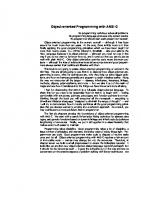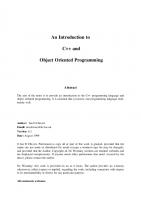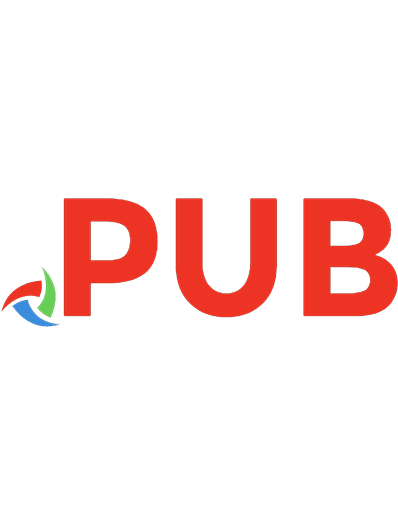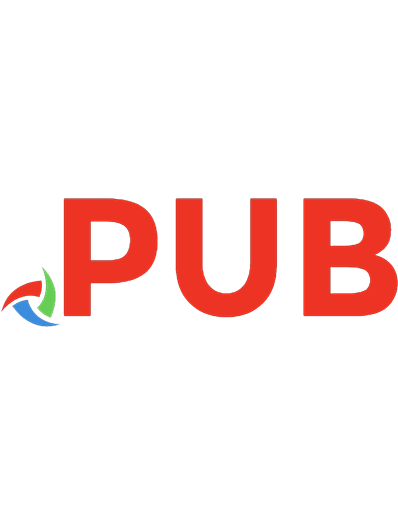Object Oriented Programming With C++ [Fourth Edition] 0070669074, 9780070669079
Written by the most well-known face of India?s IT literacy movement, this book is designed for the first course in Objec
1,445 175 39MB
English Pages 637 [656] Year 2008
Polecaj historie
Citation preview
FOURTH EDITION
OBJECT
PROGRAMMING WITH
E BALACURUSAMY
2
Now a
unique opportunity to access the
Look
lor ih&
Genuineness CenilKale
Web
Resources!
inside the
book
Scralch the srker ink an the Genuineness Certificate 1d find your Unique
A&caa* Number'
I Access
ttie
website
I CiCk on
Ilia
Flrsi
Time U«ra
Link
in
the
OLC menu
on your laH
I A[ the
bongm el
the- (ert
appearing on your right-hand side, took and click an itia Student hnk
for
Register
How
I buynv click art the link thai says:
When asked
to
I
have a registration code that came wFth
Shier yOur
«de,
1ype
in
my
book.
ywr Unique A0c*4g Number
r Create your Personalized Account by selecting your usernama and password
Click
gn
the-
Student Edition Link
Login u&no, your personaltzed
*
This number
is
meant
lor
one
fimfl
use and
is $elt
m
|he
QLC menu
on your
left
usemame and password
faslrvctibie
Copyrighted material
|R&V>
OBJECT
KA' mhemtei E5& PROGRAMMING £3fl fj&Z
WITH
^flj
Thla On*
c6KZ-DGX-5tOK ltcC material j
About the Author E Balagurusamy, former Vice Chancellor, Anna University, Cbennai, is currently Member, Union Public Service Commission, New Delhi. He is a teacher trainer, and consultant in f
the fields of Information Techno kqiy wirt M: m jgenient. He holds an ME (Hans) in Electrical Engineering and a Ph. D. in Systems Engineering from the Indian Institute of Technology, Roorkee, His areas of interest include Object-Oriented Software Engineering, Electronic Business, Technology Management, Business Process Re-engineering and Total Quality .
Management.
A
he has authored a large number of research papers and several books. His best selling books among others include: prolific writer,
,
* * » * * * A
Programming in C#, 2fs Programming in Java, 3fe Programming in ANSI C, 4/e Programming in BASlC 3/e Numerical Metbodn, and h
Itnlijahility
Engineering
numerous honours and awards, he has been lifted in the Directory of Who's Who of Intellectuals and in the Directory uf Distinguished Leaders in Education. recipient of
Copyrighted material
•
OBJECT ORIENTED
PROGRAMMING WITH
FOURTH EDITION £ Bala guru samy Member Union Public Service Commission
New
Delhi
Tata McGraw-Hill Publishing Company Limited NEW DELHI Mt Gmw-Hllt Offices
New
Delhi
New
York
Kuala Lumpur San Juan
Lisbon
5t Louis
London
Santiago
Sucj Jtudclscci
Madrid
Singapore
Auckland
Mexico City Sydney Tokyo
Bogota Milan
Caracas
Montreal
Toronto
Copyrighted material
35 Tata McGraw-Hill r
i
Published by Taia McGraw-Hill Publishing
New
7 West Patel Nagar,
Copyright
So
© 2008,
Company
Limited,
Delhi KOtlflR
2006, 200
pari of this publication
1994, by Tutu McGraw-Hill Publishing
H
may
he reproduced or distributed
mechanical, photocopying, recording, or otherwise or stored written permission of the publishers.
computer system, but they may
rial
The program
in a
listings (if
in
Lin
^
Company Limited form or by any means, electronic,
database or retrieval system without the prim
any)
may
be entered, stored and executed
in a
be reproduced for publication.
Fourth reprint 200g
DQLt KEiRMt A/VB This edition can be exported from India only by the publisher*, Tita McGraw-Htll Publishing
ISBN
1.
13 digits!:
Company
Limited.
97B-0-07-066907-9
ISBN (10
digits):
Managing
Director: Ajay Shukla
Q-Q7-0M907-4
Clcnerat Manager;
Publishing—SEM
ATech
Ed: VSbha Maftq/an
Sponsoring Rditor: SbrtiiM Jfta Spnnumriji
Jr.
Senior
Copy
F.dilor: fv'danjan Chiskrii\urt\
Kditor: Dipika
Senior Produciion Manager:
Dey P L Pundim
General Manager: Marketing— Higher Education I
'r
;
n ulT. I
Manager;
Controller
SEM &
£ School: Mithatl
Craq
Tech Ed; Riju Gctncsan
—Ptoduirtion: Rajender f Gftamelu — Production: B Dagra
Asst General Manager
I.
Information contained in [his work has been obtained reliable,
/.
However, neither Tata McOraw-Hill nor
its
t>y
Tata McGraw-Hill, from sources believed lo be
authors guarantee the accuracy or completeness of any
information published herein, and neither Tata McGraw-Hill nor
its
authors shall be responsible for any
em>ji. omissions, or damages arising out of use of this information. This work
understanding that Tata McGraw-Hill and
its.
is
published with the
authors, are supplying Jnformatioit but ore not attempting to
render engineering or other professional services, if such services are required, the assistance of an appropriate professional should be sought.
IjpoL-i
jI
Sen pi Makers
Gopsonv A-2
&. i.
M>.
A
I
l«.
Sector 64, bfoida
I.JJ.JA -
Mum-
I.
Kim. him Vi| wr
.
Neu Ik
i
i
I
in
ft?..
,ind
prnied
iti
201 301
Cover: Gopson*
Tht McGrawHffl Companies
Copyrighted materia
Contents Preface
1,
Principles of Object-Oriented
Li
Programming
\.'2
Software Crisis I Software Evolution
L3
A Look at PfriHjedurft-Qrienteii
1.4
Object Oriented Programming Paradigm fi Basic Concf?pta of Ohjflct-Orientfld Pro-am iliiirLi;;
1.5
3 Proprammiflff
4
RmftfibnfnOP
L7 1A
1 2.
Objoct-Oriciitcd
Languages
13
Applicationgof OOF 14 Summary 15 Rtuit'ii Questions 17
Beginning with C + +
19
2_L 2.2
Applications of C++
2.3
A Simplb- Q+
2L4 2.5 2.6 2.7 2.8
20
Program
gfl
Mora T-H- StatementH a5 An Example with Class 28 Stfuctmx L?f'C-t l j'uflTji[]j 29 Creatine! the? Source FUe. Mi Compiling gnd Linking JO ]
1
Debugging Exercises 33 Prfiffm mmi ng Exercises 34
^3^^jkt|ns^^p^es5^jns and Control Smictures^ Introduction
12 3.3
3,5 3.6 3.7
35.
Tokens 3iZ K^yworda 36 IdentifierH and Honatant.q Basic Data Types 38 User- Dimmed. Data Typufi Derived Data Types ¥2
_4fi
40
35
vi
#
Contents
3.8
Symbolic Constants
43
3.9
Typt* Compatibility
{5
3JJJ
Declaratinn
3.11
D>raamic Initialization of Variableg
t?
ft
3.13 3.14
3.15 3.16 3.17 \i. I
H
3.2(J
3.21
3.22 3.23 3Jil
Ri'Tr-n-rii-i-
cif
Variables
Viirmhli-ri
4A
=12
Operators in C++ 4fl Hcu pL* Kl-suJu Li in] Operator 50 Member Derefereiidtijj Operators 52 Memory Management Operators 52 Manipulators 55 'I'y i h-
f
"
;
u
j
L
O] >i- r: iltir
>
7
Expressions and their Types 5# S pec] a] A>s it Kx -ss uh s Implicit Conversions fiJ Operator Overloading 63 Operator Precedence 63 Crmtrnl Structure
m
1
\>.i l
i
1
1
i
Review Quvalion x 71 Debugging Exercises
Programming
i
75
77
4.1
IriLradnCLuMt
4Ji
The Main Function
ZZ
4,5
2£ Function Prototyping ?9 Call by Reference £J Return by Reference 82
i£
Inline Furii'tiims
4.
Default
44
4.8 4.9 4.1 0
4,11
82.
Arguments 84 const Arguments 87 Function Overloading 87 Friend and Virtiia] Function:* Math Library Fmi[:lL[)itH BO Summary 90 Review Questions} 92 Debugging Exercises 93
Programming
5*
67/
?'A
Exercises
Functions in C + +
4,3
46
fCxerrjaeif
95
C lasses and Objects £2
H Structure
5,3
Specifying a Class
SR.
9glG}
Dynamic Binding Binding refers to the linking of a procedure call to the code to be executed in response to the call, Dynamic binding (also known as late binding) means that the code associated with a given procedure call is not known until the time of the call at run-time. It is associated with polymorphism and inheritance, A function call associated with a polymorphic reference depends on the dynamic type of that reference. Consider the procedure '"draw" in Fig. 1.9. By inheritance, every object will have this procedure. ItH algorithm is, however, unique to each object and so the draw procedure will be redefined in each class that defines the object. At run-time, the code matching the object under current reference will be called.
Message Passing An
object-oriented program consists of a set of objects that
communicate with each
other.
The proceed of programming in an object-oriented language, therefore, involves the following run sic
steps:
2.
Creating dashes that define objects and their behaviour, Creating objects from class definitions,, and
3.
Establishing communication
1.
among
objects.
Objects communicate with one another by sending end receiving information much the same way as people pass messages to one another. The concept of message passing makes it easier to talk about building systems that directly model or simulate their real-world counterparts-
Copyrighted material
12 #-
A
Object-Oriented Programming with
O-
a request for execution of a procedure,, and therefore will invoke a function (procedure) in the receiving object that generates the desired result. Message passing involves specifying the name of the object, the name of the function (message) arid the information no be sent. Example:
message
for
an object
is
am ploygo. salary
^namej:
infonnalion
object
Objects have a life cycle, They can be created and destroyed. Communication with an object is feasible as long as it is alive.
1.6
Benefits of
I
OOP offers
OOP
program designer and the "user. Object-orientation contributes to the solution of many problems associated with the development and quality of software products. The new technology promises greater programmer productivity, better quality of software and lesser maintenance cost. The principal advantages are: several benefits to both the
# Through inheritance, we can
eliminate redundant code
and extend the use of exist-
ing classes.
• We can build • •
programs from the standard working modules that communicate with one another, rather than having to start writing the code from scratch. This leads to aaving of development time and higher productivity. The principle of data hiding helps the programmer to build secure programs that cannot be invaded by code in other parts of the program, It is possible to have multiple instances of an object to m-exisi without, any interference.
* # *
*
•
Tt is possible to
map
objects, in
the problem domain to those in the program.
easy to partition the work in a project based on objects. Jala-centered design approach enables us to capture more details of a model in The It is
impiementable form. Object-oriented systems can be easily upgraded from small to large systems. Message passing techniques for communication between objects makes, the interface descriptions with external systems much simpler. Software complexity can be easily managed.
While it is possible to incorporate all the.He features in an object-oriented system, their importance depends on the type of the project and the prflferen-rp of the- programmer. There are a number of issues that need to be tackled to reap some of the benefits stated above. For
C opy rig hted m ateri al
m
PrincysJes of Object - On ented Progr&MfnirtQ
13
Tbe technology in still developing and current products maybe superseded quickly. Strict controls and protocols need to be developed instance, object libraries
if reuse is
must be available
for reuse,
not to be compromised.
easy to use makes it hard to build. object-oriented programming tools would help manage* this problem.
Developing a software tbat
1
1.7
is
It ia
hoped that the
Object-Oriented Languages
not the right of Any particular language. Like structured programming, OOP concepts can be implemented using languages such as C and Pascal. However,, programming becomes clumsy and may generate confusion when the programs grow large. A language that m specially designed to support the OOP concepts makes it Object-oriented
programming
is
easier to implement them.
The languages should support several of the OOP concepts to claim that they are objectoriented. Depending upon the features they support, they can be classified into the following two categories: 1.
2.
Object-based programming languages, and Object-oriented programming languages.
Ohjfwt-hnfted
programming
in
the
style-
of
programming that primarily supports
encapsulation and object identity. Major features that are required for object-baaed
programming
* *
* *
ape-
Data encapsulation Data hiding and sccrhs mechanisms Automatic initialization and clear-up of objects Operator overloading
Languages that support programming with objects are said fcc be object-based programming languages. They do not support inheritance and dynamic binding. Ada is a typical objectbased programming language. Object-oriented programming incorporates all of object-based programming features along with two additional features, namely, inheritance and dynamic binding. Object-oriented
programming can therefore be characterized by the following statement Object-ba&ed features + Inheritance + dynamic binding
Languages that
Th«™ Table
support, these features include
C++> Smalltalk, Object Pascal and Java,
number of object-based and object-oriented programming languagHR. some popular general purpose OOP languages and their characteristics-
are a large 1.1 lists
Copy righted
material
14 •
Characteristics of some
Table 1,1
C++
Smalltulk
C'hartirtrrihtim 9.
*
Birth
Late
/
f
'
BiodLdg (early or late!
Polymorphism [la Lb.
Programming with
Object Oriented
hiding
•-•
.-iDfLl
C
"".
Both
Both
Early
Object
Eiffel
Fcueul
*
1
..I.
Early
Rnrly
Bnth
/
*
V
•i
v
S
ConcnTTTurv
OOP fonrjuugtui
V
s
l'..i:.r
No
Pciac"
Mb
Promised.
-
J
i : ..;
'i
!
.unic
v
„.
..
No
*
No
t
V
No
No
In tit) fit;* tint;
Garbage
•
*
Collect km
Same
hi,.
No
\,
Persist* new
No Object
Nu
N
No
•
No
No
No
Np
Support
Nd
Ncrt
..-
Litn-fLfLte
SGL
much *
Pure
object-oriented languages
** Object- boxed tan/ruaees
Others are extended conventional language*
As seen from Table
1. 1
,
all lanfiuap*cs
provide for polymorphism and data hiding. However,
many of them do not provide facilities for concurrency, persistence and Ada and C++ provide generic facility which is an important ei instruct for
genericrty, Eiffel,
supporting reuse. However, persistence (a process of storing objects is not fully supported by eny uf them. In Smalltalk, though the entire current execution state con "be saved to disk, yet the individual objects cannot be saved to an external file. )
Commercially, C+-+- is only 10 years uld, Smalltalk and Objective C 13 years old. and Java only 5 years old. Although Simula has existed lor mors than tv- u
assembly language
>
C++
>
classes
>
concurrency
> >
data abstraction
>
data hiding
> >
data members
>
early binding
>
Eiffel
hottom-up programming
data encapsulation
dynamic binding
> > > > > > > > > > > > >
flowcharts function overloading
functions jjurbagp LyJIettign glcmal data
hierarchical classification
inheritance
Java late binding krcal
data
machine language
member
functions
message passing
(Contd)
Copyrighted material
Principles of Object-Oriented
• 17
Programming
rm* Hilda
>
iifKTr
>
modular programming
>
iKTiiistence
>
r>)uitiplf^ iilklLTi LSiijCi:
>
IKjlymorphiam
>
object libraries
>
procedure-oriented programming
Object Pascal
> > >
object'based
>
object-oriented
Objective
overloading
reusability
> >
programming
C
Simula Smalltalk
object-oriented languages
structured
programming
objects
programming
>
tup-down programming
>
Turbo Pascal
Review Questions 1.1
What do you think
1.2
Briefly discusa the software evolution
1.3
What
1.4
Discuss an approach
1.5
Describe
how data
What
object-oriented
1.6
is
is
oriented
are the major issues facing the software industry today!
during the period 1960 — 1990-
procedure-oriented programming? What are to
are.
shared by functumx
in
programming? How
1.8
What are
1.9
Distinguish between the following terms:
a procedure -oriented program. is it different
ore data the
and functions organized
from the procedure-
program? unioue advantages of an object-oriented programming paradigm?
and
in
an
(a)
Objects
(a)
Data abstraction and data encapsulation
object-oriented
classes
and polymorphism fd) Dynamic binding and message passing 1.10 Whul kinds of things can become objects in OOP? 1.11 Describe inheritance- as applied to OOP, 1. 12 What do you mean by dynamic binding? How in it
How
characteristics?
programming?
How
1.13
main
the development of procedure-oriented programs,
1.7
(c>
its
Inheritance
useful in
OOP?
does object-oriented approach differ from object-based approach f
OOP technology. statement* are TRUE or FALSE.
1.14 List a few areas of application of
1.15 State whether the following (a.
In procedure-oriented programming, all data are shared by all functions.
(bl
The main emphasis of procedure-oriented programming
i
is
on algorithms
rather than on data.
C opy rig hted m ateri al
Object -Oriented Pyogmmtruf\ef uath 0>
(c)
One of th e striking features of object -oriented pmgra fuming programs
(d)
is
the
d i v r« inn
of
knawn
an
into objects that represent real-world entities.
Wrapping up of data of
different types into a Kindle unit
is
encapsulation. (e) (f)
(g)
(h)
One problem with OOP is that once a
ciaxa
is
created
it
van never he changed.
means the ability to reuse the data values of one object by Polymorphism is extensively used in implementing inheritance. Object-oriented programs are executed muck fanfcr than conventional Inheritance
programs. (i.)
Object-oriented systems can scale up better from small to large.
(j)
Object-oriented approach cannot be used to create databases.
Copyrighted material
2 Beginning with C++
Key Concepts
|2.1
What
is
C++?
is, an object-oriented programming language. It was developed by Bjarne Strougtrup at AT&T Bell Laboratories in
C++
Murray Hill New Jersey, USA, ,
V
C wilh
> V ^
C++ features Main function C++ ctjmtnetitH
V
Output operator
* y
Input operator
>
RH urn Statetnunt
>
Namespace
^
Variables
y
Cascading of operators
P y y y >
C++ program
cla.mws
Header
File
structure
Client-server model
Source
file
creation
Ccimpilation
Linking
in
the early
an admirer of Simula67 and a strong supporter of C wanted to combine the best of both the tanguatfeK and create a more powerful language that could support object-oriented programming features and still retain the power and elegance of C. The result was C++. Therefore, C++ is an extension of C with a major addition of the class construct feature of Simula67, Since the class wag a major addition to the original C language, Stroustrup initially called the new language C with classes'. However, later in 1963, the name was changed to C++, The idea of C++ comes from the C increment operator ++, thereby suggesting that C++ is an augmented (incremented) version of C. 1980's. Stroustrup,
t
During the early the language underwent a number of improvements and
Copyrighted material
•
20
Object Oriented Progrumn\inxj with
changes. In
November
1997, the
and added several new features
0
+
ANSI/ISO standards committee standardised these changes to the
language specifications.
C++ is a superset of C. Most of what we already know about C applies to C++ also. Therefore, almost all C programs are also C++ program^. However, there are a few minor diffe.ranraii that will prevent a C program in run under C++ compiler, We shall see these differences later as
and when they
are encountered.
The most important facilities that C++ adds on to C are clashes, inheritance, function overloading, and operator overloading. These features enable creating of abstract data types, inherit properties from existing data types and support polymorphism, thereby making C++ a truly object-oriented language, The
object-oriented features in
and ease
clarity, extensibility
C++
allow programmers to build large programs with
of maintenance, incorporating the spirit
and
efficiency of C,
The addition of new features has transformed C from a language that currently
facilitates
top-down, structured design, to one that provides bottom-up, object-oriented design.
[2,2
C++ in
C+ +
Applicat ions of
a versatile language for handling very large programs.
any compilers, databases, communication 1
1
1
-
.-ui
table for virtually
programming task including development of editors, systems and any complex real-lite application systems.
* • • *
1
2.3
Since C++ allows us to create hierarchy-related objects., we can buildspccial objectoriented libraries which can be used later by many programmers. While C++ is able to map the real-world problem properly, the C part of C++ gives the language the ability to get close te the machine- level details. C++ programs are easily maintainable and expandable. When a new feature needs t» ht> implemented, it is very «asy Lo add to the exiting utructurft of an objectIt is expected that C++ will replace C as ajsenerul-uurpose Language in the near future.
C++
A Simple
Program
Let us begin with a simple example of a
PUNTING
*
include
C + + program
that prints a string on the screen.
STRING «=1
ast
rearr.>
// include header file
usi^g namespace 5td; (Ctmtd)
Copyrighted material
*
Beginning with C**
21
int mainf) cokft
«
"C++ is better thin C.\n";
return 0; ^
1
^
ffiypj^y
^
// C++ Jttfteitwfll
;
c^ example
if'(^0^^^
fRWWW
This simple program demonstrates several
C++
£.1
features.
Program Features Like C, the C++ program
is
a collection of functions.
The above example contains only one
mainO. As usual, execution begins at mainO- Every C++ program must have a mainO. C++ is a free- form language. With a few exceptions, the compiler ignores carriage returns and white spaces, Like C the C++ statements terminate with semicolons. function,
Comments C++
new comment symbol // double slash). Comments start with a double symbol and terminate at the end of the line, A comment may start anywhere in the slash line, and whatever fallows till the end of the line is ignored. Note that there is no dosing introduces a
i
Symbot-
The double slash written as follows: // // //
comment is
basically a single line
comment. Multiline comments can be
This is art example of C++ program to illustrate Some Qf its feotvres
The C comment symbols i x " / are still valid and are more suitable for multiline comments. The following comment is allowed: ,
/*
This
is.
an example of
C++ program to illustrate same of its features
7 We can use either or both styles in our programs. Since this is a boot on C++ we will use only the C+ + style. However, remember that we can not insert a # style comment within the text offl program line. For example, thtf double slash comment cannot be used in the* manner as shown below: ,
forfj-0; j^n;
/* loops n times */ j+*J
C opy rig hted m ateri al
22 •
Object-Oriented Programming with C+ +
Output Operator The only statement cout
«
in
Program
2,1 is
"C++ is better than C.
causes the string
in quotation
an output statement. The statement H ;
marks
to
be
«
displayed
on
the screen. This statement 1
Thy
introduces two new C++ features, 4-imt and identifier cout (pronounced as 'C out ) is a predefined ithjetrt that represents the standard output Htretim in C++- Here,, the standard redi reel the output to other output Output stream rep resents the screen. Ft is also possihk I
devices.
We shall later discuss sLreums in
The operator
Contains classes and functions used by the standard library to allocate memory to the standard library containers. Contains classes
for
manipulating data in the standard library
containers
Contains functions
for
manipulating data
in the
standard Library
containers. c exceptions
cstdexcept*
These header
files
contain classes that arc used for exception
handling.
Contains the definition of class string from the standard Library. Discussed in Chapter 15
Contains function prototypes for functions that perform input from strings in memory and output to strings in memory.
![Demystified Object-Oriented Programming with C++ [1 ed.]
9781839218835](https://dokumen.pub/img/200x200/demystified-object-oriented-programming-with-c-1nbsped-9781839218835.jpg)






![Python 3 Object Oriented Programming [1st edition]](https://dokumen.pub/img/200x200/python-3-object-oriented-programming-1st-edition.jpg)
![Object-Oriented Programming (OOP) using C++ [2 ed.]](https://dokumen.pub/img/200x200/object-oriented-programming-oop-using-c-2nbsped.jpg)

![Object Oriented Programming With C++ [Fourth Edition]
0070669074, 9780070669079](https://dokumen.pub/img/200x200/object-oriented-programming-with-c-fourth-edition-0070669074-9780070669079.jpg)